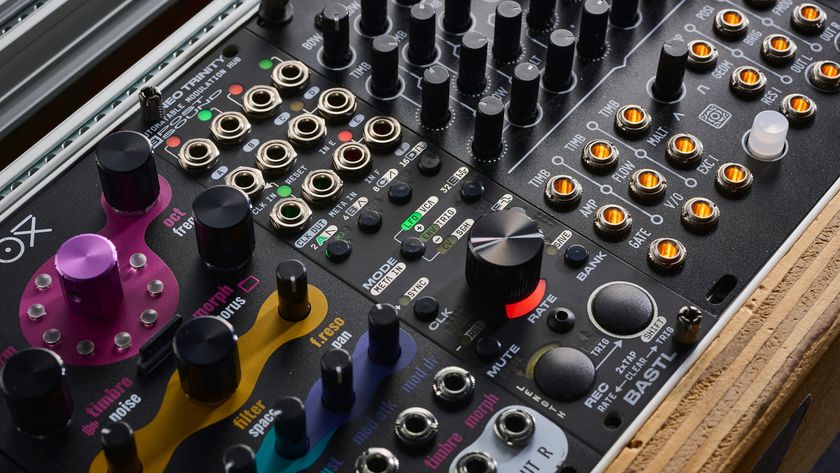Blur the line between rhythm and lead guitar with these smart playing approaches
10 ideas that will help you handle both roles in your band

Many guitar techniques, perhaps most, can’t really be categorised as either purely for rhythm or purely for lead, and a ‘chords and solos’ way of thinking may actually limit your creativity. Here we’re looking at a mixture of ideas that bridge the gap between rhythm and lead.
They are, of course, short examples but play through each one with the aim of developing the musical ideas. Each line could easily be more focused on lead or more on chords... or neither. It’s up to you!
1. Octaves - Fighting On The Green

This punk-rock riff is inspired by bands like Green Day and Foo Fighters, who often use octaves to form melodies. Holding down the octave shape means you can’t indulge in widdly solos, so you’ll more likely be focusing on the melody and how it works with the chord progression. The technique is also used a lot in jazz.
2. Pedal tones - Lick Of The Bay

James Bay fills out his sound in songs such as Hold Back The River and Let It Go by allowing the open third string to ring out (known as a pedal tone) with his two-note chords. Try our simpler lick, which should be played fingerstyle. There are only really two chord shapes here – the all-important open string provides the colour.
3. Chord fills - Wing It

In this example we stack notes of the D major pentatonic scale to provide a cascade of fills that are beautifully melodic, but without the thin sound you sometimes get with single-note solos. Jimi Hendrix was a master and players like Stevie Ray Vaughan and John Mayer have adopted similar approaches.
4. Jazz chord melody - Mmm, Nice!

With often complex harmony and tough playing techniques, jazz guitar strikes fear in the heart of most players, but you can get started with this simple, yet sophisticated chord melody. The challenge is making sure you leave the correct finger free to play the melody notes that follow each chord.
5. Chord tones - Blue Riffing

The G and Eb notes in bar 1 are found in the Cm7 chord (C Eb G bb) they’re played over – giving a sense of the chord in the lick itself. After a blues scale run the initial lick is repeated at the end in a true call-and-response fashion.
Get the MusicRadar Newsletter
Want all the hottest music and gear news, reviews, deals, features and more, direct to your inbox? Sign up here.
6. Funk groove - Le Lick, C’est Chic

Inspired by guitarists like Nile Rodgers and Jimmy Nolen this riff features chords and muted pick strokes punctuated with staccato single-note lines. This mix of techniques and sounds gives a groovy, percussive rhythm style, peppered with melodic interest too. A little compression and reverb are the icing on a funky cake.
7. Fingerstyle - Country Living

Our country-style, fingerpicked groove combines a bassline with chords and a melody all in one. Practise the bassline on its own to begin with – use your thumb for this. You can then add in the melody notes and bring the part up to speed. Our D7 chord is the same as an open C7 shape, but played two frets higher.
8. Chords and lead - Strait Talkin’

When it comes to intertwining lead lines and chords with his vocals, Mark Knopfler is one of rock’s very best. Take a look at our Dire Straits-inspired lick and you’ll see a mix of lead fills, two- and three-note chords, plus bending, sliding, hammer-ons and vibrato. Despite all the action, our lick isn’t too challenging. Just practise slowly!
9. Open strings in riffs - Funky Rocky

Thanks to their resonant nature, open strings can really fill out your sound. The E7#9 chord we looked at earlier is also used to great effect here in this funk-rock riff inspired by guitarists such as John Frusciante and Richie Kotzen. The muted 16th-note strumming adds in that funky quality to the proceedings.
10. Harmonics and tremolo picking - Hale To The King

Maybe it was thanks to sheer virtuosity, but despite being van Halen’s sole guitarist in the early days, Eddie always seemed to fill in the gaps. To keep things interesting in our typical EvH line, the two-note chords keep changing and then we switch to a whammy-bar harmonic and a fast tremolo-picked line.
Chris has been the Editor of Total Guitar magazine since 2020. Prior to that, he was at the helm of Total Guitar's world-class tab and tuition section for 12 years. He's a former guitar teacher with 35 years playing experience and he holds a degree in Philosophy & Popular Music. Chris has interviewed Brian May three times, Jimmy Page once, and Mark Knopfler zero times – something he desperately hopes to rectify as soon as possible.











